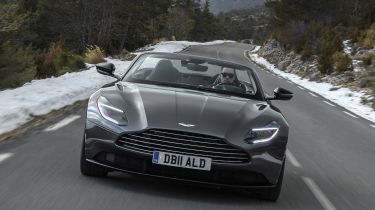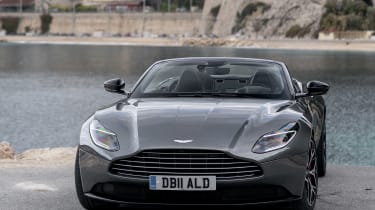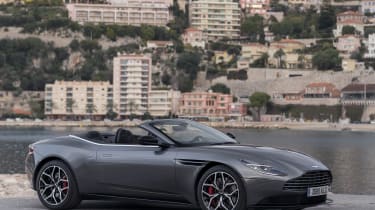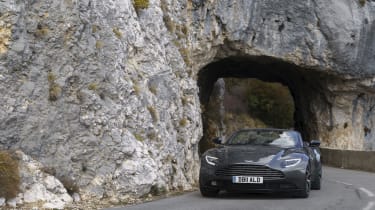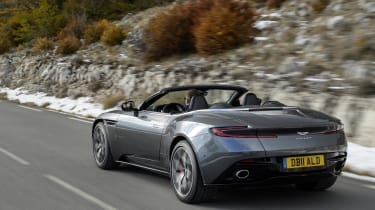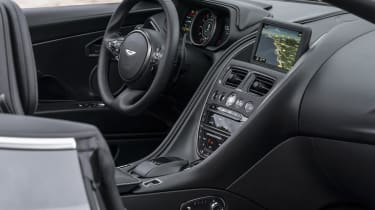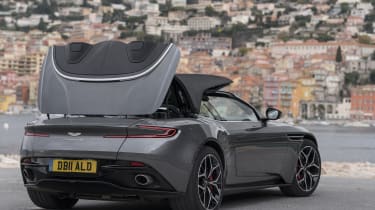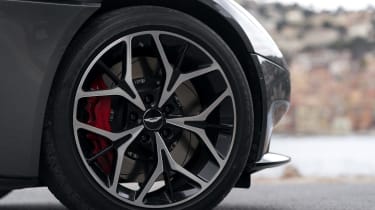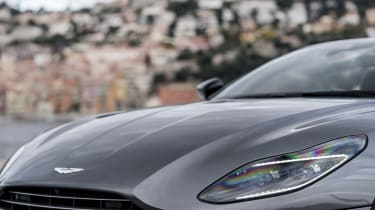Aston Martin DB11 Volante
"The Aston Martin DB11 is already a great car and it appeals even more in convertible Volante form"
Pros
- Arresting looks
- Precise steering
- Addictive soundtrack
Cons
- Limited visibility
- More expensive than coupe
- Slight shimmy on rough roads
The Volante name first appeared in 1965, as a drop-top version of the Aston DB5 immortalized by 007 in the James Bond novels and films. Since then, every new convertible to be launched by the the famous English marque has been awaited with bated breath, and the DB11 Volante was no exception.
For reasons that are hard to explain, removing a car's roof adds a touch of glamour, no matter how prosaic the hard-top version might be. Starting with a car as dramatic and elegant as the Aston Martin DB11, the new Volante was always bound to be a looker. That's good news, because the the car from Newport Pagnell faces some pretty eye-catching competition – the Ferrari Portofino, Maserati GranCabrio, Mercedes S-Class Coupe, Mercedes SL and Mercedes-AMG GT roadster are all fearsome rivals.
When a car has such a combination of looks and image, many will sign the order form without so much as starting its engine, but there's far more to the Volante than a pretty face. The DB11's roof-removal surgery was a serious operation, going as far as increasing the thickness of structural metalwork and reworking the chassis to ensure rigidity. And after removing the bandages, it's clear that the transformation was a complete success.
More reviews
In-depth reviews
In fact, with clever modifications under the front end, the steering feels even sharper and more responsive than the DB11 coupe's. There's no shortage of power, either – the twin-turbocharged V8 engine produces 503bhp and will launch you from 0-62mph in just 4.1 seconds. With the roof down, its crackling snarl is all the more visceral, too. Not only do you look good behind the wheel, but onlookers get a clear view of the broad grin on your face.
The electric roof is something of a masterpiece, too. Made from eight layers of fabric, it folds neatly enough to leave a gracefully flush rear deck. It looks the part when erected and eschews the slightly awkward roofline of the DB11 coupe.
Some might moan about the lack of a V12 engine option, but the Mercedes-AMG-sourced V8 proves more than up to the task without clashing with the car's character. Only a higher price weakens the Volante's claim to be the default DB11 choice, but that's unlikely to be a sticking point for those who fall for this Aston's charms.
MPG, running costs & CO2
Aston Martin claims 28.3mpg can be coaxed from the DB11 Volante when driven moderately, while 230g of CO2 will leave the exhaust every kilometre. Interestingly, this is a little wide of the 30.1mpg and 219g/km figures claimed by Mercedes for the GT S Roadster, which uses the same engine as the Aston Martin.
If you're lucky enough to claim a DB11 Volante as a company car, you can expect to face a 37% Benefit-in-Kind (BiK) tax bill. Expect high insurance premiums, too – the DB11 falls into to group 50, the highest insurance grouping there is, and coverage costs can vary massively depending on your circumstances.
You can expect the Volante's running costs to increase dramatically the moment you start making full use of its performance capabilities. Frequent blasts of maximum acceleration will rapidly see you on first-name terms with your local petrol-station staff, and nearby tyre and brake specialists might enjoy your custom on a regular basis, too – and the bills won't be small.
Every Aston Martin boasts a three-year/unlimited-mileage warranty, with the option of extension for two further years at extra cost.
Engines, drive & performance
Many convertible sports cars spend their lives trundling, roof-down, along Mediterranean promenades or blasting away from the lights in swanky urban neighbourhoods. It would be a crying shame for a DB11 Volante to be kept on such a tight leash, though – it really has a lot more to offer than pure posing potential.
Aston Martin engineers made herculean efforts to prevent the impressively stiff DB11 going floppy when the top was sliced off. Precautions such as stiffening the metal used in the car's sills, installing new front and rear crossmembers and structural front undertray largely make up for the lack of a fixed roof.
It's actually still only 65% as rigid as the coupe, but the reinforcements at the front have worked wonders on the steering – the Volante feels sharper and more responsive at the wheel than its coupe sister. You sit low and the imposing view down that long body can obscure forward vision in corners, but the positive feel through the steering really helps you place the car with confidence. There's little bucking or shaking on rough roads, either, thanks to a smooth ride that belies the cleverly designed suspension.
The Volante weighs 110kg more than the V8-engined coupe, but this only marginally blunts its performance – 0-62mph takes a tenth of a second longer, at 4.1 seconds – and the 4.0-litre V8's soundtrack is something to savour, too. Despite two turbochargers, accelerator response is very sharp in Sport+ mode, where lifting your foot from the pedal results in evocative crackles and pops from the exhaust.
GT mode softens the suspension and calms the engine a little, but you have the choice of combining settings to your taste – it's tempting (and more than a little mischievous) to adopt the smoothest ride and most aggressive engine settings as the default.
Interior & comfort
Set to the softest GT driving mode, the Volante becomes a comfortable companion for high-speed motorway trips and is all the better for never losing the slightly firm feel you expect of a thoroughbred sports car. Surface imperfections are dealt with in a fuss-free way without feeling floaty – think orthopedic mattress as opposed to waterbed.
Passengers won't find the Volante wanting for convenience, either. Power-adjustable heated seats are standard, as are cruise control, keyless entry and go and an eight-inch infotainment screen. The latter displays sat-nav information and images from the car's 360-degree camera. If you go for the optional heated steering wheel, the Volante becomes a roof-down proposition all year round.
It's something of a shame that the Aston Martin's interior finish isn't quite as top-notch as you might expect. Although clearly assembled with care and precision, some of the materials and components feel out of place in such an expensive car, particularly the rather basic-looking air vents.
Although adaptive cruise control is on hand, the DB11 can't match the semi-autonomous driving technology offered by the Mercedes S-Class Cabriolet, although handing the controls over to a computer would rather defeat the point of such a driver's car.
Practicality & boot space
Practicality should always be discussed with a small 'p' when it comes to cars like the DB11 Volante – they're not designed for versatility. Even exotic convertibles need to be user-friendly, though, and the Aston has lost none of its usability with its conversion from coupe to cabriolet.
You can operate that intricate folding roof when driving at speeds of up to 31mph – it takes 14 seconds to open and 16 seconds to close. You can turn the Volante topless remotely using the key, too. Roof up, the Volante isn't a lot noisier inside than the coupe and you won't encounter much wind buffeting even when it's down. It's possible to sense a bit of structural vibration that's absent in the coupe, though.
It's clear that Aston Martin knows the DB11 will need to slot into family life for many, and the two rear seats, while tiny, are equipped with ISOFIX mountings so child seats can be installed. The boot is far from hopeless, too – at 224 litres, it's actually 20% larger than that of its DB9 Volante predecessor. You can fit a good long-weekend's worth of soft luggage in there, or two sets of golf clubs if you'd rather.
The same convenience caveats apply to the Volante as the regular DB11, though – a heavily raked windscreen makes the view along that long bonnet as awkward as it is impressive, and the big mirrors cause blind spots at some junctions. There's very little view through the rear screen when the roof is up, either. These are shortcomings that are equally true of most cars of this kind, though.
Reliability & safety
In this rarefied part of the car market, evaluating owner satisfaction is a very subjective task. Undeniable performance, style and image mean it's unlikely that many are disappointed with their Aston Martin, even though the brand has seen little coverage in any reliability surveys – it has yet to feature in our annual Driver Power owner satisfaction study, for example.
The reliability of a DB11 Volante ought to be assured, though, by its use of proven Mercedes-AMG engines. While built by experts on a special production line – just like the hand-built Aston Martin V8s of previous years – the fact that this twin-turbocharged engine is used in cars as diverse as the Mercedes-AMG C63 and AMG GT Roadster suggests a certain amount of dependability – a commodity you can't always take for granted on a largely bespoke car built in comparably tiny numbers.
Too few DB11 Volantes are expected to be sold for independent Euro NCAP crash testing to be warranted, but the sheer strength of its structure suggests it'll protect occupants nicely should the worst happen.
There are six airbags, too, while a lane-departure warning system and adaptive cruise control add to safety on the motorway. Stability control is fitted, but enthusiastic drivers will be pleased to find it's been calibrated to allow just a little exuberance when engaged, and can be turned off altogether. Even without the extra safety net it provides, the DB11's powerful brakes will scrub off high speeds again and again without their stopping power diminishing.
Price, value for money & options
The Aston Martin DB11 Volante costs the thick end of £160,000 – that's around £15,000 more than the fixed-roof DB11 coupe. However – price discrepancy aside – it's hard not to see the Volante as the more appealing of the two.
Die-hard driving enthusiasts will decry the Volante's loss of overall rigidity, but the reality is that it only rears its head in a slight vibration through the car's structure when passing over uneven road surfaces. So much attention has been paid to ensuring stiffness where it counts that few could possibly argue that the Volante comes up short on driving fun compared to its coupe sister.
And only the most emotionally detached could fail to appreciate the extra joy that comes from having no metal barrier between your ears and that intoxicating exhaust note. Take the roof down and the Volante is a more involving experience than the coupe – you really are placed at the centre of the action.
The difficulty comes in whether to give the Volante the nod over its talented rivals, and the Ferrari Portofino is particularly hard to ignore. At the end of the day, the two are almost impossible to separate where it comes to summing up the experience they offer – you may as well choose which of the two best melts your heart when you look at it.

